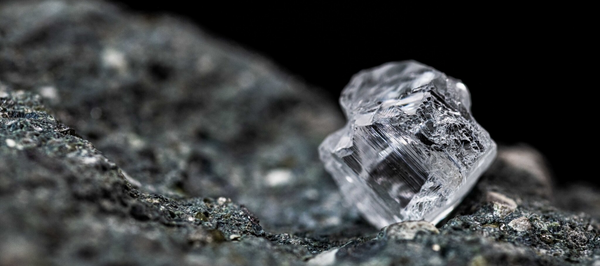
The diamonds in your ring or necklace look vastly different before they go under the knife and many rounds of polishing before they end up in your jewelry. Raw, uncut diamonds possess a unique, untouched allure. This guide aims to demystify the world of raw diamonds, offering insights on their appearance and tips for distinguishing genuine gems from similar-looking stones.
What Does a Raw Diamond Look Like?
Raw diamonds, also known as rough or uncut diamonds, display a dull, glassy luster quite unlike their polished counterparts. Their surface may appear translucent to opaque, with some showing yellow or brown tinges and, more rarely, other colors.

Characteristics of Rough Diamonds
- Shape: Typically, raw diamonds exhibit irregular shapes, sometimes resembling a dodecahedron with multiple facets, starkly different from the crafted sparkle of cut diamonds.
- Texture: A rough diamond's surface might feel greasy or waxy, contrasting with the smooth facets of polished stones.
- Hardness: As the hardest natural substance, a genuine raw diamond can scratch glass or softer gemstones, indicating its authenticity.
- Luster: Unlike polished diamonds, raw diamonds might not sparkle brilliantly but should reflect light with a distinctive, glassy sheen.
How Do You Identify a Raw Diamond
- The Fog Test: When you breathe on a diamond like a mirror, any fog should dissipate immediately, thanks to diamonds' rapid heat dispersion. Lingering fog suggests it may not be a diamond
- The Water Test: Dropping the stone into water tests its density; real diamonds sink quickly due to their high density, whereas imitations may float or sink slowly.
- Use of a Professional Loupe: Jewelers generally inspect gems with a loupe to reveal the intricate internal structure unique to diamonds, hard to replicate in fake stones.
Can I Test a Raw Diamond at Home? How?
Although there are some simple tests you can perform at home to identify a raw diamond, these are not foolproof, and false positives are common with some other gemstones or synthetic materials. For a more definitive identification, you would eventually need to consult a professional gemologist. Here's how you can start the process at home:
1. Visual Inspection
- Look for specific crystal shapes: Raw diamonds often resemble tiny, clear or slightly tinted geometric shapes, like octahedrons (eight faces), tetrahedrons (four faces), and cubes (six faces). However, not all diamonds will have a perfect shape due to natural erosion.
- Check for a metallic shine: Diamonds have an adamantine luster, meaning they should have a brilliant shine similar to metal.
2. Water Test
- Density check: Fill a glass with water and gently drop the stone into it. Diamonds have a high density, so they should sink quickly. If the stone floats or sinks slowly, it's likely not a diamond. However, this test is not 3. to diamonds; other heavy minerals will also sink.
3. Fog Test
- Check thermal conductivity: Hold the stone between your fingers and breathe on it to create a light fog. A real diamond disperses heat quickly, so the fog should clear up almost instantly. If the fog stays on the stone for a few seconds, it may not be a diamond. This test can be unreliable since some diamond-like materials also disperse heat well.
4. Heat Test
- Test for thermal stability: Diamonds are incredibly resistant to heat. You can heat the stone for about 30 seconds and then drop it into cold water. A real diamond will not crack or break. Be cautious with this test, as it can destroy many gemstones and is not recommended for stones of unknown origin.
5. Hardness Test
- Scratch test: Use the stone to try and scratch a piece of glass. Since diamonds are the hardest natural material, a true diamond should easily scratch glass. However, this test can damage both the stone and the surface it's being tested on and should be used as a last resort. Additionally, other materials like moissanite and some manufactured materials can also scratch glass.
Limitations and Cautions
- False Positives: Many of these tests can give false positives because other materials can exhibit similar properties to diamonds.
- Risk of Damage: Some tests may damage the stone or other property. Use caution and consider the potential value of the stone before attempting any destructive test.
- Professional Verification: These home tests can indicate whether a stone might be a diamond, but they cannot confirm it with certainty. For an accurate identification, take the stone to a certified gemologist or a reputable jewelry store.
Identifying a raw diamond at home is challenging and requires careful consideration of the results. If you believe you have a real diamond based on these preliminary tests, the next step is to seek professional verification for a conclusive identification.
Factors Affecting Identification
Quality of the Raw Diamond: The clearer and more crystal-like the stone, the easier it is to suspect it might be a diamond, but it also could be mistaken for other clear stones.
Size and Weight: Larger stones might undergo more rigorous testing due to their potential value.
Presence of Impurities: Natural diamonds often contain impurities or flaws, which can aid in identification but also confuse inexperienced observers.
Experience and Equipment: The level of experience of the person conducting the identification and the quality of the tools at their disposal can significantly affect the accuracy of the identification.
Raw, Uncut Diamond vs. Other Minerals
Raw, uncut diamonds and similar-looking minerals such as quartz and calcite often confuse even the keenest eyes. The true distinction lies in specific characteristics unique to diamonds.
Hardness is a definitive factor; diamonds are the hardest known natural material, capable of scratching virtually any other substance, including these look-alike minerals.
Luster also plays a crucial role; diamonds exhibit a distinctive, greasy luster, unlike the glassy or vitreous shine of quartz and calcite.
Specific gravity further separates diamonds from their mimics; diamonds have a notably higher density.
For those seeking absolute assurance, a gemologist’s appraisal is essential, utilizing specialized equipment and expertise to differentiate with certainty.

Are Raw Diamonds a Good Investment?
In the realm of precious stones, raw diamonds hold a unique position. Their allure isn't just in their natural beauty, but also in their potential as a sound investment. Unlike polished diamonds, whose values are often dictated by market trends and aesthetic qualities such as cut, clarity, color, and carat, raw diamonds' value stems from their rarity and the natural characteristics they exhibit.
Market Trends and Rarity:Raw diamonds, especially those with unique features or colors, can see their value increase over time. Their market is less saturated than that of cut diamonds, making them a niche but potentially lucrative investment.
Long-term Appreciation:Given their timeless appeal and the finite nature of diamond resources, raw diamonds can appreciate, especially as demand for sustainable and ethically sourced gemstones grows. This appreciation, however, is influenced by factors such as size, quality, and the current market demand.
Investment Considerations:Before investing in raw diamonds, conducting thorough research or consulting with a gemologist is crucial. Understanding the market, the provenance of the diamond, and having a clear authenticity verification are essential steps to ensure that your investment is sound.







